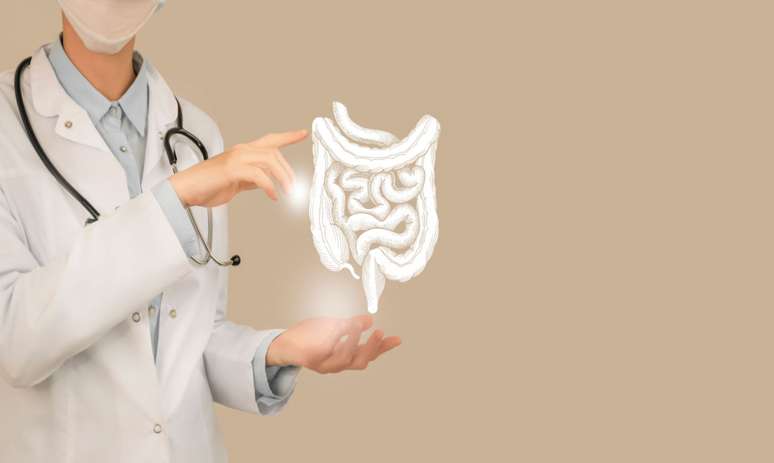More and more people under the age of 50 are being diagnosed with colorectal cancer. Know how to spot warning signs
Colorectal cancer is the fourth most common type in Brazil, second only to non-melanoma skin, breast and prostate cancer. According to the National Cancer Institute (Inca), there are about 45,630 cases of the disease in the country every year in the three-year period 2023-2025.
html[data-range=”xlarge”] figure image img.img-a200c08a1eb2c125ab36800447af6a15pbi7p0ai { width: 774px; height: 463px; }HTML[data-range=”large”] figure image img.img-a200c08a1eb2c125ab36800447af6a15pbi7p0ai { width: 548px; height: 328px; }HTML[data-range=”small”] image figure img.img-a200c08a1eb2c125ab36800447af6a15pbi7p0ai, html[data-range=”medium”] figure image img.img-a200c08a1eb2c125ab36800447af6a15pbi7p0ai { width: 564px; height: 337px; }
More and more young people are getting colorectal cancer
Studies conducted in Europe and the United States have shown an increase in cases of colorectal cancer in young people, which has put specialists on alert. A survey by the American Cancer Association showed that, in 2023, cases of colorectal cancer in the United States will reach 153,000. Of the numbers, 13% will be people under 50. From 2020 to today, this increase represents 9%.
In Brazil, the scenario is no different. Inca indicates a 35% increase in patients in the same age group between 2011 and 2016: out of 5,806 medical records analysed, 781 people were under 50 years old. Although the entity confirms that there is an increase in the incidence of the disease in young patients, there are still no data that can measure the scenario in the country today.
Colorectal cancer
A colorectal cancer develops in the large intestine (the colon or its final portion, the rectum). The main type of colorectal cancer is adenocarcinoma and, in 90% of cases, it originates from polyps in the region. Without identification and treatment, these polyps can change over the years and can turn into cancer.
The main form of diagnosis and prevention is through monitoring of the colonoscopic examination. In the procedure, a device that has a camera on its tip is introduced into the intestine to create images that reveal whether there are any possible changes. In Brazil, the Ministry of Health recommends starting colon and rectal cancer screening in the low-risk adult population over the age of 50.
“After age 50, the chance of having polyps increases, remaining between 18% and 36%, which consequently represents an increased risk of malignancies arising from the condition at that stage of life. “, explains Dr. Renata D’Alpino, oncologist at Grupo Oncoclínicas.
Emphasize that people with a personal history of polyps or inflammatory bowel disease (such as ulcerative colitis and Crohn’s disease), as well as family records of colorectal cancer in one or more first-degree relatives (especially if diagnosed earlier age 45), should pay more attention and carry out periodic checks before the baseline age indicated for the general population.
Symptoms and stages of the disease
According to oncologist Dr. Artur Ferreira, the characteristic symptoms and signs of colorectal cancer are:
- Cold;
- Diarrhea;
- Narrowing of the caliber of the stools;
- Absence of the feeling of relief after defecation, as if not all the fecal contents had been eliminated;
- Blood in stool;
- cramps;
- Weight loss for no apparent reason;
- Weakness and tired feeling
If the diagnosis is positive, the specialist will assess the stage of the tumor through tests and classify it, indicating whether or not other organs are involved.
I – tumor confined to the most superficial parts of the intestine, such as the mucosa, submucosa or muscular layer of the colon or rectum and without involvement of regional lymph nodes (ganglia);
II – tumor confined to the serosa lining the colon or rectum or affecting nearby organs, but not involving regional lymph nodes;
III – tumor involving lymph nodes close to the colon or rectum, regardless of its local extension;
IV – tumor affecting distant organs (metastases).
early diagnosis
Fortunately, colorectal cancer has a high chance of being cured in the vast majority of cases. However, it is very important that the diagnosis is made as early as possible through routine tests, as this increases the success of the treatment.
The oncologist says there are many taboos surrounding preventive colorectal cancer screening, which contributes to poor adherence to early disease control, even among people in the highest risk group.
“Often the tumor is only discovered later, in the face of more severe symptoms, such as anemia; constipation or diarrhea with no apparent cause; weakness; gas and abdominal cramps; and weight loss,” he warns.
“Although blood in the stool is an initial indication that something is not right with their health, many people tend to attribute this event to other conventional causes, such as hemorrhoids, and end up putting off seeking medical advice and execution of specific tests . that many people discover cancer only in advanced stages”, completes the specialist.
Prevention
For this reason, primary and secondary prevention of the disease must be strongly encouraged and encouraged. The primary refers to changes in eating and lifestyle habits, such as investing in foods with more fiber and dairy products and avoiding red and processed meats. These lifestyle changes also include tackling obesity, exercising regularly, and avoiding smoking and alcohol consumption.
Secondary prevention relies on tests for fecal occult blood and imaging, with an emphasis on colonoscopy, the primary tool for identifying colorectal cancer. While simple, performing a colonoscopy is still a taboo to overcome, as is overlooking symptoms for fear of seeking help.
“This procedure is able to identify more serious and silent problems, such as cancer, as well as Crohn’s disease and ulcerative colitis. Therefore, it is essential to convey quality information to society with the aim of raising awareness of the importance of colonoscopy and, above all, warn that the examination can save lives”, completes the specialist.
Treatment
The doctor explains that there are two ways to treat the neoplasm:
Local treatments (surgery, radiotherapy, embolization and ablation): they act directly on the primary tumor or on isolated metastases, without affecting the rest of the body. Therefore, they can be indicated both in initial cases and in the more advanced stages of the disease.
Systemic treatments (chemotherapy, immunotherapy or targeted therapies): it can be performed by oral (pills) or intravenous (into a vein) medication, applying directly into the bloodstream. We need both early and advanced cases of the disease.
Renata D’Alpino reiterates that healthy lifestyle habits are protective factors that contribute to reducing the risk of the disease. Therefore, it is essential to invest in a diet rich in fiber and to exercise regularly. This cure can help not only in the prevention of colorectal cancer but also in fighting the growth of cancer cases as a whole.
Source: Terra
Ben Stock is a lifestyle journalist and author at Gossipify. He writes about topics such as health, wellness, travel, food and home decor. He provides practical advice and inspiration to improve well-being, keeps readers up to date with latest lifestyle news and trends, known for his engaging writing style, in-depth analysis and unique perspectives.








